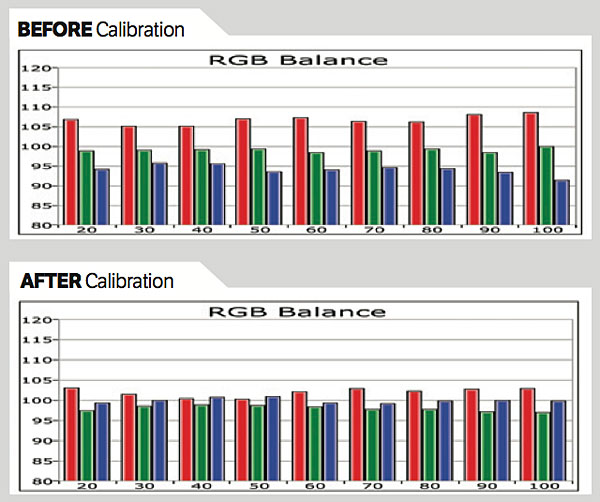Panasonic TC-L55WT60 3D LCD HDTV Test Bench
Full-On/Full-Off Contrast Ratio: Unmeasurable
I performed pre-calibration measurements of the TC-L55WT60 in its Cinema preset/Warm2 color temperature mode with all adjustments left at their default settings. Post-calibration measurements were made in Professional1 mode with adjustments for dim room viewing. The TC-L55WT60 switches off its backlight when faced with displaying a 0-IRE (black) signal. My usual course of action in this situation is to make contrast ratio measurements with a 0-IRE test pattern that contains a narrow above-black bar, but in this case the Panasonic’s aggressive A.I. Picture backlight dimming prevented me from doing that. With A.I. Picture switched to Off, black level measured 0.008 ft-L and 37.23 ft-L on a 100-IRE pattern to yield a native contrast ratio of 4,654:1. Maximum brightness in Cinema mode with the backlight setting pushed to maximum was 106 ft-L; in Vivid mode, it was 123 ft-L.

The average Delta E of the set’s pre-cal grayscale averaged out to a not-so-impressive 7.5; post-calibration, it was a much-improved 2.8, with a high of 3.9 at 100 percent brightness. (Delta E is a figure of merit that indicates how closely a display adheres to the Rec. 709 HD color standard. Experts generally agree that levels below 3 are visibly indistinguishable from perfect color tracking.)
The Delta E of the set’s color points in Cinema mode averaged 0.7—an excellent showing. At 2.1, the set’s 2.2 default gamma setting deviated just slightly from the 2.2 dim room target.
Picture uniformity was below average for a high-end LCD model. I noted some screen clouding on both test patterns and program content, though corner spotlights disappeared when the set’s Mid or High A.I. Picture mode setting was enabled. Off-axis uniformity was excellent, with contrast remaining uniform from virtually any angle—a typical result for a TV that uses an IPS (In-Plane Switching) panel.

The Panasonic passed the clipping test from the Spears & Munsil High Definition Benchmark Blu-ray. However, it failed the 2:2 cadence test in the disc’s Source Adaptive Deinterlacing section and the Jaggies test in the Edge Adaptive Deinterlacing section. The same phenomenon that prevented me from carrying out a contrast ratio measurement with the A.I. Picture mode enabled—a tendency for just-above-black content to be swallowed up whole—also prevented me from fine-tuning black level using S&M’s low PLUGE and Dynamic Range patterns.—AG
- Log in or register to post comments




















































